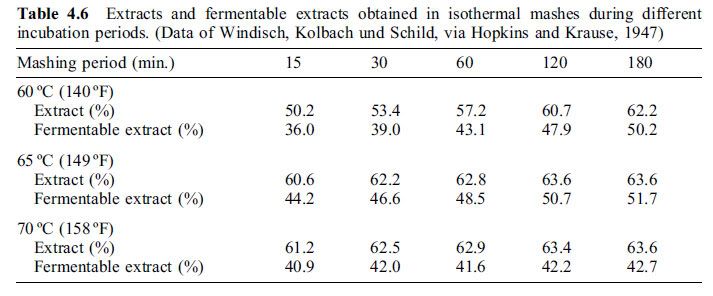SJW
As you must brew, so you must drink
- Joined
- 10/3/04
- Messages
- 3,401
- Reaction score
- 211
Alpha Amylase Effects on Wort Fermentability over Time.
A similar experiment was documented on the braukaiser.com web site some time ago with somewhat inconclusive results.
Aim: To find out if alpha amylase activity alone increases wort fermentability after full conversion in a mash where beta amylase was not activated.
Method: The plan is to mash 5kgs of pale IMC malt continuously for 3 hours at 73 deg C and draw off 1 litre samples at 30min, 1 Hr, 1.5 Hrs, 2 Hrs and 3 hrs. Using the Braumeister it will be a simple task to heat strike water to about 76 deg C and hold at 73 deg C for the allotted times.
Then boil each sample for 10 mins in an Erlenmeyer flask, cool in an ice bath and transfer to a P.E.T. bottle for fermentation. I plan on getting the 1 litre samples drawn, boiled and cooled in between collecting each sample.
Then I will pitch 3 grams of US-O5 in each sample.
The results will include O.G, F.G. and apparent attenuation.
My Theory: I am assuming that by using a modern well modified malt a protein rest would no be required, to emphasise shorter chained protein or amino acids, even though I am not planning on activating Beta Amylase or Limit dextrinase at all.
My thinking is that Alpha Amylase working randomly on glucose molecules should create some maltose by splitting glucose chains thus converting all the Amylose.
Question 1: While Beta Amylase splits 2 glucose molecules at the non reducing end of a glucose chain, would the above mentioned random activity of Alpha Amylase by chance do the same job? GIVEN ENOUGH TIME? Thus converting some if not all Amylose. This should create enough maltose for the yeast to do its job and make some alcohol in the wort.
And the question I am trying to find the answer to is, given enough time would Alpha Amylase convert enough starch to produce a fermentable beer?
Amylopectin will be delt with by the Alpha Amylase and given enough time this experiment should find out if extended Alpha Amylase activity on the Amylopectin will produce a suitably fermentable wort. Ie, some maltose.
Any thoughts on this would be appreciated. The other way I could go would be to dough in well below gelatinisation temps and raise the temp 1 deg C per min. (in the Braumeister) and going straight to 73 Deg C, this would give Beta Amylase about 5 or 6 minutes to create some maltose.
Thoughts.
A similar experiment was documented on the braukaiser.com web site some time ago with somewhat inconclusive results.
Aim: To find out if alpha amylase activity alone increases wort fermentability after full conversion in a mash where beta amylase was not activated.
Method: The plan is to mash 5kgs of pale IMC malt continuously for 3 hours at 73 deg C and draw off 1 litre samples at 30min, 1 Hr, 1.5 Hrs, 2 Hrs and 3 hrs. Using the Braumeister it will be a simple task to heat strike water to about 76 deg C and hold at 73 deg C for the allotted times.
Then boil each sample for 10 mins in an Erlenmeyer flask, cool in an ice bath and transfer to a P.E.T. bottle for fermentation. I plan on getting the 1 litre samples drawn, boiled and cooled in between collecting each sample.
Then I will pitch 3 grams of US-O5 in each sample.
The results will include O.G, F.G. and apparent attenuation.
My Theory: I am assuming that by using a modern well modified malt a protein rest would no be required, to emphasise shorter chained protein or amino acids, even though I am not planning on activating Beta Amylase or Limit dextrinase at all.
My thinking is that Alpha Amylase working randomly on glucose molecules should create some maltose by splitting glucose chains thus converting all the Amylose.
Question 1: While Beta Amylase splits 2 glucose molecules at the non reducing end of a glucose chain, would the above mentioned random activity of Alpha Amylase by chance do the same job? GIVEN ENOUGH TIME? Thus converting some if not all Amylose. This should create enough maltose for the yeast to do its job and make some alcohol in the wort.
And the question I am trying to find the answer to is, given enough time would Alpha Amylase convert enough starch to produce a fermentable beer?
Amylopectin will be delt with by the Alpha Amylase and given enough time this experiment should find out if extended Alpha Amylase activity on the Amylopectin will produce a suitably fermentable wort. Ie, some maltose.
Any thoughts on this would be appreciated. The other way I could go would be to dough in well below gelatinisation temps and raise the temp 1 deg C per min. (in the Braumeister) and going straight to 73 Deg C, this would give Beta Amylase about 5 or 6 minutes to create some maltose.
Thoughts.





